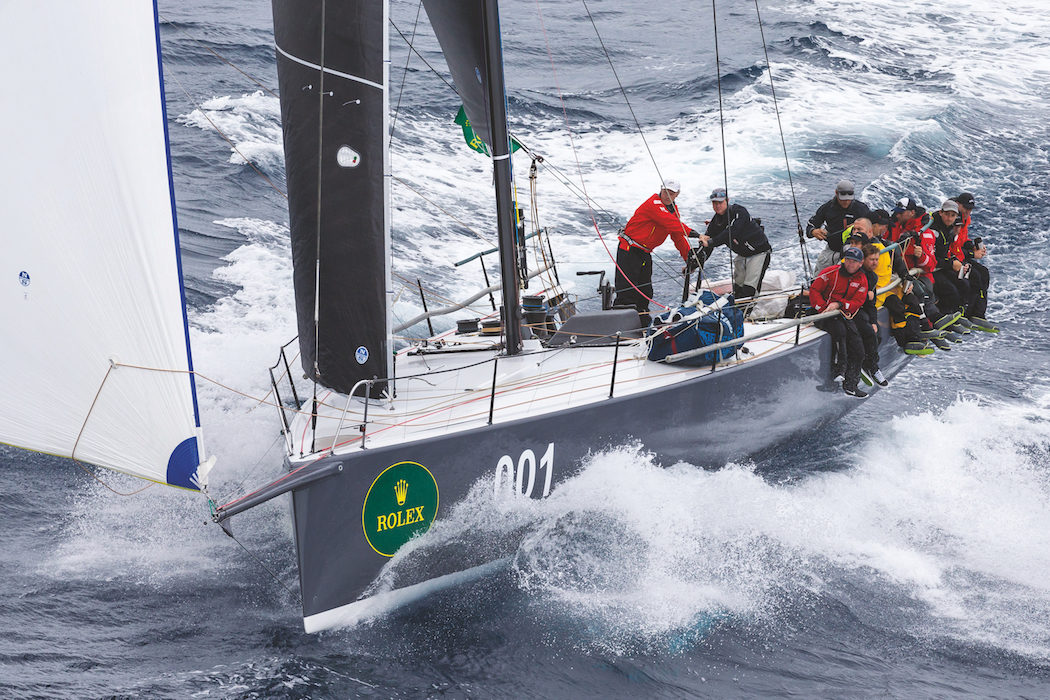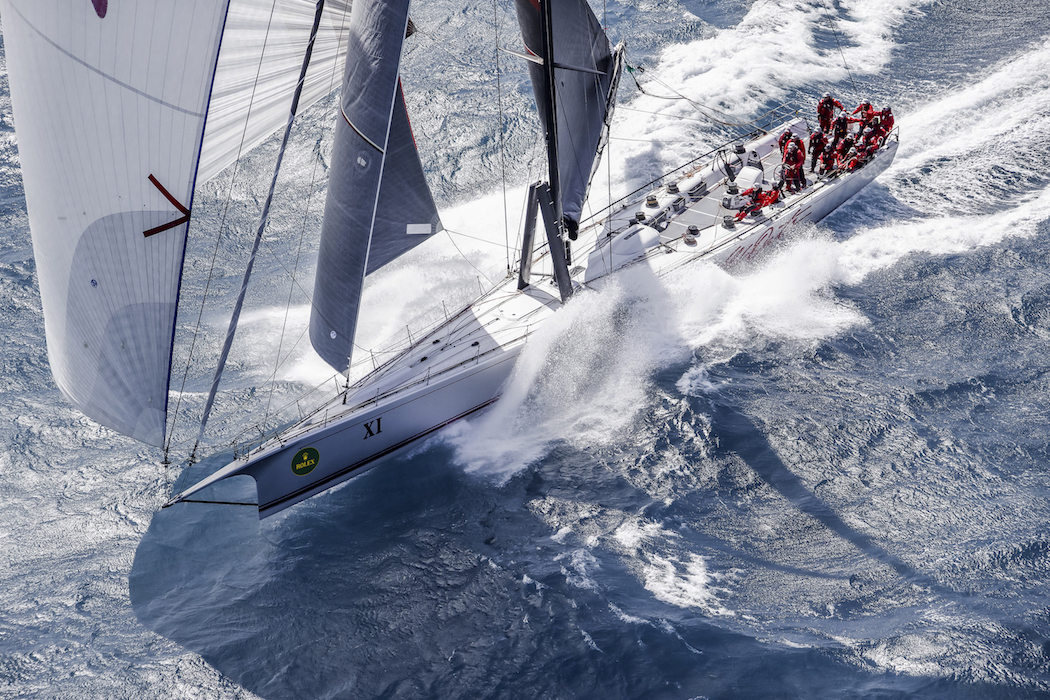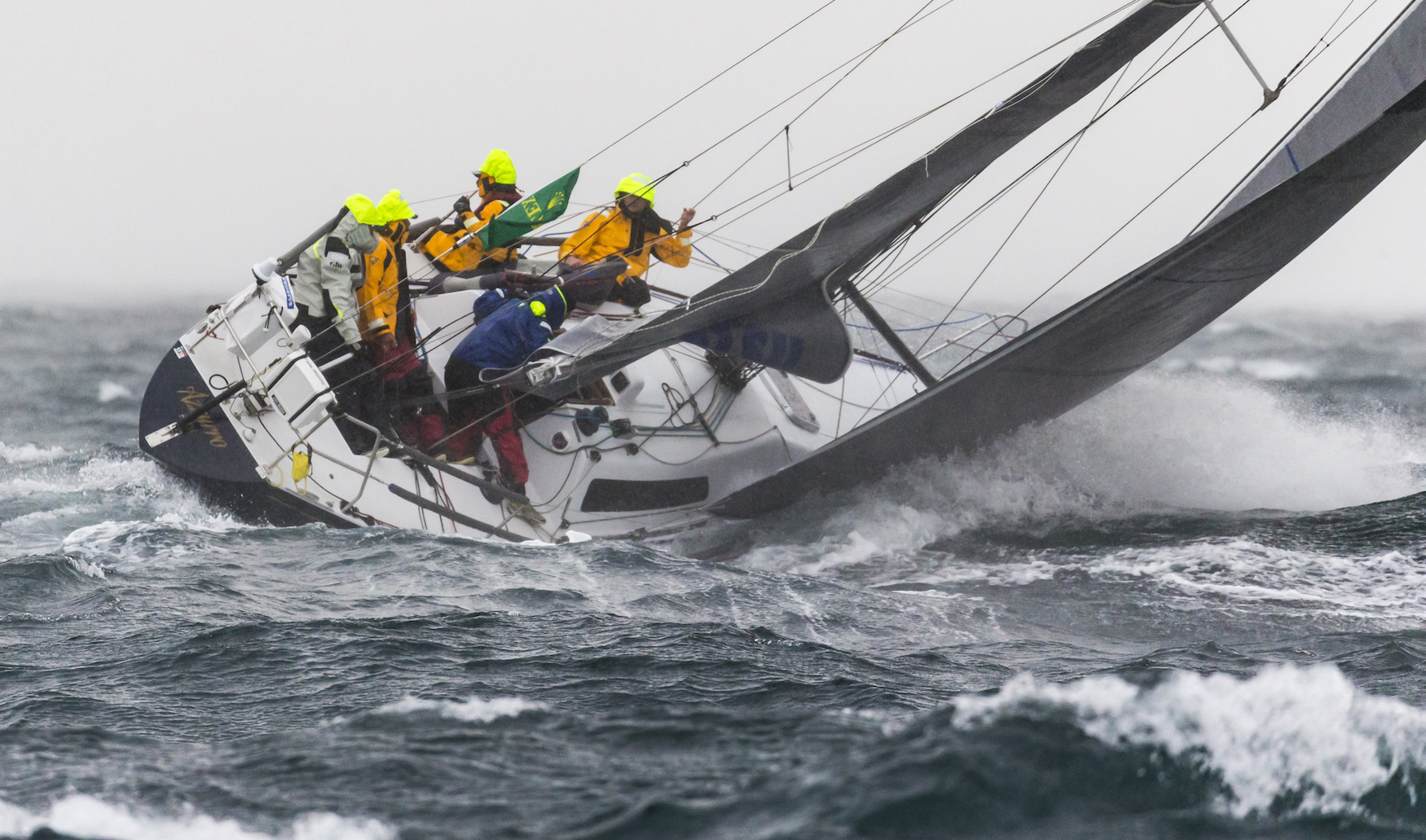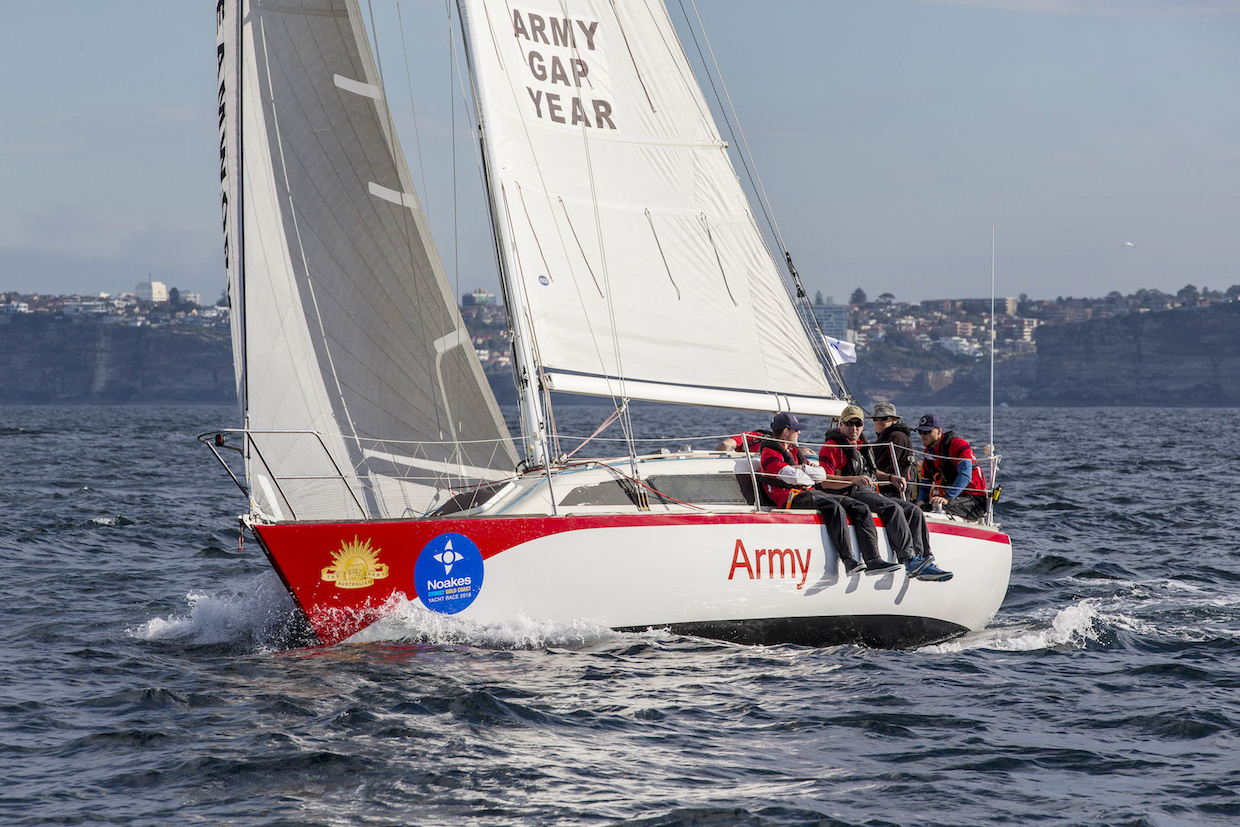Proving ground
Every Rolex Sydney Hobart is different. After the glamour runs of the past two years many sailors are bracing for a ‘traditional’ Bass Strait welcome. Kevin Green analyses the main contenders and why the race continues to attract those with a thirst for adventure.
Photography by Carlo Borlenghi / Andrea Francolini
23 December 2018
Advertisement
A major feature this Boxing Day will be the strong collection of 60-plus-footers that will form a formidable chasing pack behind the five 100-foot supermaxis. The 60s will also provide some real competition for the dominant TP52 class, which has supplied two out of the last three overall winners of the race to proudly claim the Tattersall Cup.
Among the contingent of 60s is polymath Sean Langman, returning to the big time with something to prove on the newly acquired RP 65 Naval Group (formerly the USA-based Moneypenny). The Sydneysider loves the race out of Sydney Heads so near sister ships – Tasmanian Phillip Turner’s RP66 Alive; the immaculately prepared mini Wild Oats X; along with the well-performing Reichel Pugh 63 Voodoo (renamed from Limit by Hugh Ellis) – will have to keep an eye on their wing mirrors.
Yet another strong contender is the nimble Mark Mills-designed 68 that achieved several honours when called Alegre (then CaoI lla R) before her current incarnation as Prospector with Terrance Glackin at the helm. Should the going get tough, the Volvo 70s might be in with a shout, and given Giacomo’s giant feat of second over the line in 2016, the nippy Juan K-designed Maserati should take heart if the wind rises.
Joining them will be a local yacht that’s recently found some winning ways; the LC60 Triton. Owned by David Gotze and Michael Cranitch, it will give legendary sailor Tony Ellis his 51st Hobart race, equalling Tony Cable’s record for the most Sydney to Hobarts by an individual.
Advertisement
Yet another handicap chance is the Carkeek 60 Winning Appliances (the renamed Ichi Ban). Chartered by Troy Tindill, she retired from November’s Cabbage Tree Island Race, but will be much better prepared come Boxing Day. According to mainsheet trimmer Micah Lane, who is hoping for mixed conditions, “We know the boat is fast; she’s had several mods since launching in 2013.”
Also on board will be father and son team John and Herman Winning. Veteran John said he’s never had an easy Hobart and doesn’t anticipate anything different this time – “Hopefully it will be a lot quicker than my last one in 1996!”
Experienced navigator Adrienne Cahalan is very happy to be doing her 27th race on the competitive Voodoo. “The TPs are nearly unbeatable with their rating, so it’s a real challenge to choose a boat that might have a chance against them. You need the weather to shut off between the 60s and
the TP52s,” she explained.
Meanwhile, Wendy Tuck – 2018 Australian Female Sailor of the Year, inaugural Offshore Sailor of the Year and Clipper Round the World Race winning skipper – will join Zoe Taylor on the Cookson 12 Grace O’Malley.
TP masterclass
Many of the 11 TP52s will be strong contenders for the Tattersall Cup this year, but defending champion Matt Allen, the first Australian to have one built, has the newest TP52 and will be hard to beat. Designed by Botin Partners, Ichi Ban launched last year with increased structure to give her better offshore capabilities than the primarily regatta/downwind boats.
Following in the wake of Quest – the double Rolex Sydney Hobart winner and the first TP52 to arrive in Australia – Ichi Ban gave Allen a win in the Newcastle Bass Island Race and then his first Rolex Sydney Hobart as an owner.
This year she has taken a swathe of cups in various competitions including the Brisbane Gladstone Race and the Sydney Gold Coast Race. Several TP52s will be nipping at her heels again as they did in the Gold Coast Race – Celestial, Gweilo and Envy Scooters all followed Ichi Ban closely, finishing within two hours of each another.
Celestial owner and CYCA Rear Commodore Dr Sam Haynes was very pleased with this showing of first in ORCi Division 1, saying: “We’ve taken 300 kilograms out of the bulb and expect to get out of the water and go faster off the wind this year.”
A new rudder is also being fitted to the 2006-built TP52. Haynes will be among a crew of 14 for the Rolex Sydney Hobart. After recovering from a bad bicycle accident, this will be his first hit-out and he’s relishing the thought: “Mixing it with the likes of Ichi Ban will be great.”
Another good effort among the TPs came from newcomer Gweilo. Cantonese slang for white man, she was launched as Container in 2011. New owners Matt Donald and Chris Townsend have assembled a crack crew led by veteran Mike Green who commented, “It has the pedigree; we’ll see if we can make it do the numbers in the Rolex Sydney Hobart.”
Another TP52 and the race’s first Hungarian entry, M3 Team Hungary will be skippered by Aron Ormandlaki. Further endorsement of this growing class was an announcement in August of a TP52 Australian circuit, which aims to equally rate the 14 boats of all ages in this country.
Pursuit runners
Fancied 50s include some other well-prepared boats such as the successful American Scott Innes-Jones’ Cookson 50 Privateer; Victorian John Newbold’s RP51 Primitive Cool; and French NMYD 54 Teasing Machine III.
Another boat doing much more than making up the numbers is Tony Kirby’s regatta-winning, McConaghy-built Patrice, a five-year-old, Jason Ker-designed 46-footer with all-round weather abilities. Improving performance in the light airs, which included taking 700 kilograms off the keel, has really improved Patrice’s one major weakness. According to Kirby, “The boat has been performing really well this year and I’m excited about having my youngest crew ever.”
Key among the 13-strong crew this year will be navigator Michael Bellingham and some teddies again, part of fundraising for his Kids’ Cancer Project.
Another pocket performer is the small but dangerous overall handicap winner of the Gold Coast Race, Bruce Taylor’s RP 40 Chutzpah, which will have some Taswegians aboard.
Prominent among the classic yachts is Kialoa II with veteran Lindsay May doing the naviguessing; something the recently knighted Australian relishes. “My thing is the current. Just 1–2 knots under your keel in the right direction makes a huge difference to your overall time. IMOS charts show the general location of current flows, but the speed is hard to accurately predict. It’s a matter of trying to set up your course to intersect the southerly flow or avoid counter currents.”
Precision and performance
Unlike the 86 other competing yachts, the aim of the five supermaxis is simple: to be the first to cross the line in Hobart. The winner takes all. Along with defending champion Comanche and eight-time winner Wild Oats XI will be Oats’ sister ship Black Jack, the 2016 winner InfoTrack and the Chinese-owned Scallywag.
The supermaxis justifiably get the popular media vote and this year the drag race out of the Heads can be viewed free-to-air on 7Mate and tracked on the Rolex website. The tight confines of the harbour combined with the sheer speed of the 100-footers always amazes me. Clashes do happen – like the port/starboard infringement last year that proved costly for Wild Oats XI when the time penalty lost her the race in favour of Comanche.
When asked later if he regretted not doing the penalty turns, skipper Mark ‘Ricko’ Richards said, “When we looked at the footage afterwards we thought it was a bit too close, but that’s the decision we made and you’ve got to live by your decisions.”
Unsurprisingly, the Wild Oats XI crew are hoping to put the last three consecutive – and disappointing – Rolex Sydney Hobart Yacht Races behind them. The owners, the Oatley family, have since spent money on her, including what Richards described as “likely the fastest spinnaker we’ve ever had on the boat.”
In addition, Oats has also had reaching struts added (long poles pioneered by the IMOCA 60s that allow a refinement of the sheeting angle for the spinnakers), making Richards excited about this year: “Our boat is going to be faster than it’s ever been before,” he says.
Meanwhile, Jim Cooney has prepped Comanche with attention to light air performance (see page 34 for the details).
Interestingly, these boats are configured for different conditions so will be following a variety of strategies during the 628-nautical-mile race. One indicator for the upcoming race was the result from the July Noakes Gold Coast Race that saw four of these supermaxis go head to head for the two-day race from Sydney.
The predominately light air race was won by the oldest of these boats, the 2005-built Black Jack (formerly Alfa Romeo), which was acquired last year by experienced racer Peter Harburg and skippered by Mark Bradford. This Rolex Sydney Hobart-winning boat and winner of multiple international races has quickly returned to form in Australia, as Bradford explained to the media: “We’ve tilted our yacht entirely for light air. It’s all about lift and minimising drag in the light airs.
“We’ve got the lightest supermaxi to start with and the least wetted surface area. When it’s about seven knots we have a big advantage, but when it gets up to 15 knots, Comanche has the advantage.”
Nearly twice the beam, Comanche is predominately a heavier air boat, so came a distant third. Meanwhile Wild Oats XI had a match-racing battle with Black Jack and was pipped at the line by just two minutes. “It’s always good to do a match race when you’ve got the speed advantage for the conditions!” laughed Mark Bradford.
For the Rolex Sydney Hobart Yacht Race, it’s understood that Black Jack has made several modifications, increasing all-round performance and adding 600 kilograms to the carbon hull. Comanche has gone the other way, reducing ballast by 800 kilograms to increase off-the-wind performance.
Owner and software supremo Christian Beck’s beamy InfoTrack finished 57 minutes behind the other three supermaxis in the Gold Coast Race and was well back in the last Rolex Sydney Hobart. “Last year it was pretty clear that we were the shitbox of the supermaxi fleet, but this year we have top secret modifications that should get us well out of that category.”
Like Comanche, InfoTrack prefers heavy conditions that allow her to use the wide beam to carry plenty of sail, especially on a reach – as she did while winning the 2016 Rolex Sydney Hobart Yacht Race in record time for then-owner Anthony Bell.
The only maxi missing from the Gold Coast Race was Scallywag – her crew was competing in the pinnacle ocean-racing event, the Volvo Ocean Race. Sadly during the event skipper David Witt lost one of his crew and close mate John Fisher, whose body was never recovered after falling overboard.
For the 2018 Rolex Sydney Hobart Yacht Race the crew and owner Seng Huang Lee will be fitting a deeper keel to the 100-footer, originally named Ragamuffin 100 when campaigned by the legendary Syd Fischer.
Foreign legion
Prominent among the 13 international entries this year is the seasoned crew of French Nivelt-Muratet 54 Teasing Machine III. Owner Eric de Turckheim has unfinished business with the Rolex Sydney Hobart after being in the leading pack during the 2015 race until the Derwent River’s infamous glass out-scuppered his chances.
“We are here to win; not just make up the numbers,” affirmed trimmer Bertron. And they might just do that, with Teasing Machine III beating even maxis recently when they won the 2017 RORC Transatlantic Race.
Among her attributes is a good handicap rating for not having a keel bulb, while tactician Laurent Pages and navigator Jean-Luc Nelias are a formidable partnership. These Frenchmen took the same roles for skipper Franck Cammas, winning the 2011–12 Volvo Ocean Race, and Nelias won the 2017 Transat Jacques Vabre on giant trimaran Sodebo Ultim with Thomas Colville, smashing the race record.
Another quality-built contender is the X-50 Lunatix from German Friedrich Boehnert, which potentially has the legs in a medium-wind race.
The Corinthians
My first Rolex Sydney Hobart on a 38-footer still ranks as one of the hardest yacht races I’ve done. And so it is for many club sailors like Tony Levett on his Sydney 38 TSA Management; one of only three this year.
Even more uncomfortable will be the army crew on the 30-foot Gun Runner, the smallest yacht in the 91-boat fleet, along with some bouncy 36-footers like Midnight Rambler and South Australian Caillin Howard’s 37-footer Aikin – Hames Sharley.
For the vast majority of these sailors, the Rolex Sydney Hobart Yacht Race is their Everest. Completing it is the goal, but doing it in a small yacht is by far the hardest – and arguably greatest – achievement.
We wish all boats fair winds and a safe passage.
Advertisement
Advertisement
Advertisement






